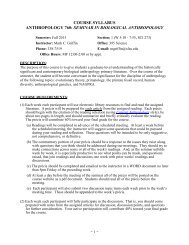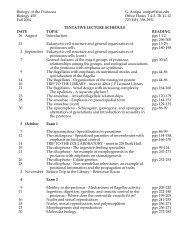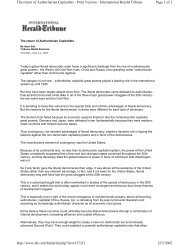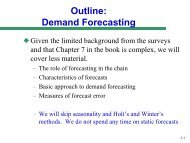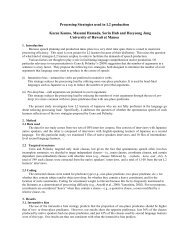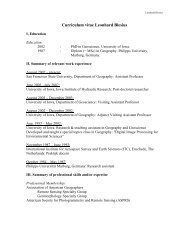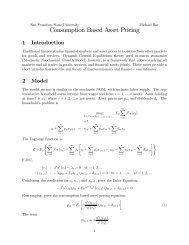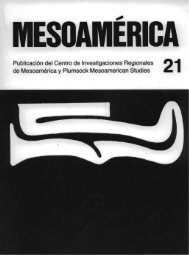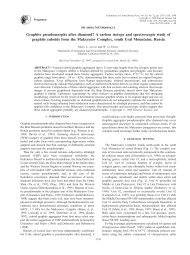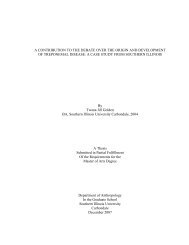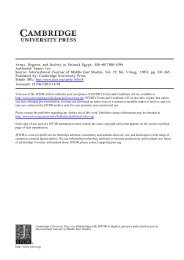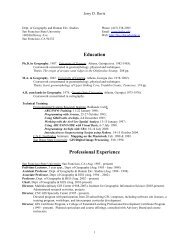WORKSHEET 13 INVERSES OF SQUARE MATRICES In the last ...
WORKSHEET 13 INVERSES OF SQUARE MATRICES In the last ...
WORKSHEET 13 INVERSES OF SQUARE MATRICES In the last ...
Create successful ePaper yourself
Turn your PDF publications into a flip-book with our unique Google optimized e-Paper software.
<strong>WORKSHEET</strong> <strong>13</strong><br />
<strong>INVERSES</strong> <strong>OF</strong> <strong>SQUARE</strong> <strong>MATRICES</strong><br />
DAVID MEREDITH<br />
<strong>In</strong> <strong>the</strong> <strong>last</strong> worksheet, you showed that if A is a square matrix, <strong>the</strong>n A has a<br />
left inverse if and only if it has a right inverse if and only if <strong>the</strong> number of rows or<br />
columns is <strong>the</strong> rank of A. <strong>In</strong> fact any one-sided inverse of A is <strong>the</strong> unique two-sided<br />
inverse of A, denoted A −1 .<br />
(1) Show that a square matrix has an inverse if and only if it row reduces to<br />
<strong>the</strong> identity.<br />
(2) <strong>In</strong> Octave construct a 5 × 5 matrix A of rank 5.<br />
(3) Construct B = A −1 with <strong>the</strong> following commands, and show <strong>the</strong> results are<br />
all <strong>the</strong> same:<br />
A^(-1), eye(5)/A, A\eye(5), inverse(A), inv(A)<br />
Check that AB = BA = I.<br />
(4) Construct a column vector b with five entries. Solve <strong>the</strong> equation Ax = b<br />
by calculating x = A −1 b. Show that <strong>the</strong>re are two ways to calculate <strong>the</strong><br />
answer with Octave: x = A^(-1)*b, x = A\b. Check that your solution<br />
is correct.<br />
(5) For 2 × 2 matrices <strong>the</strong>re is a simple formula for <strong>the</strong> inverse, when it exists.<br />
Put Octave aside for([ a moment. ]) a b<br />
(a) Show that rank<br />
= 2 if and only if ad − bc ≠ 0. Argue that<br />
c d<br />
<strong>the</strong> matrix has rank 2 iff its rows are linearly independent iff <strong>the</strong> rows<br />
are not parallel iff ad − bc ≠ 0. Fill in <strong>the</strong> gaps in <strong>the</strong> argument. The<br />
quantity ad − bc is <strong>the</strong> determinant of <strong>the</strong> matrix. (Extra information:<br />
larger square matrices also have determinants, which are 0 precisely<br />
when <strong>the</strong> matrix is not invertible. However <strong>the</strong> formula for <strong>the</strong> determinant<br />
is complex, so it’s best to let Octave calculate determinants of<br />
larger matrices with <strong>the</strong> command det(A).)<br />
[ ] −1 [ ]<br />
a b 1 d −b<br />
(b) Show that =<br />
.<br />
c d<br />
[<br />
ad<br />
]<br />
− bc −c a<br />
2 3<br />
(c) Find <strong>the</strong> inverse of and check your answer.<br />
1 4<br />
(6) Suppose you were on a desert island and needed to invert a matrix. Here’s<br />
a procedure you could use. You could also use this procedure in your own<br />
computer program if you needed to invert a matrix.<br />
(a) Construct a 5 × 5 matrix A of rank 5 in Octave. Check that <strong>the</strong><br />
row-reduced form of A is I.<br />
(b) Form <strong>the</strong> double-wide matrix B = [A| I] with <strong>the</strong> command B=[A,eye(5)].<br />
(c) Row-reduce B to a matrix C: C=rref(B).<br />
Date: March 18, 2010.<br />
1
2 DAVID MEREDITH<br />
(d) You should get C = [I| D]. The matrix D is A −1 . Recover D with<br />
<strong>the</strong> command: D = C(:,6:10) and check that AD = DA = I.<br />
Department of Ma<strong>the</strong>matics<br />
San Francisco State University<br />
San Francisco, CA 94<strong>13</strong>2<br />
E-mail address: meredith@sfsu.edu<br />
URL: http://online.sfsu.edu/~meredith



